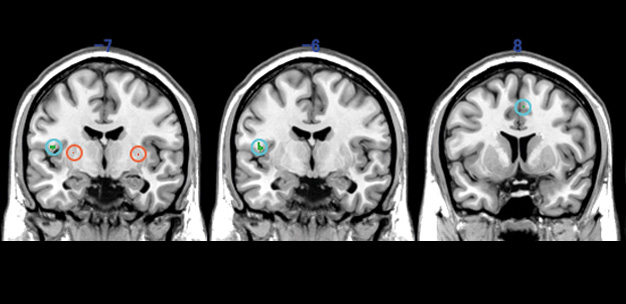Emotions arise in brain regions that link the triad of mind, body and brain
Published online 6 August 2015

Magnetic resonance imaging scans comparing volumes of gray matter in postural tachycardia syndrome (PoTS) cases with controls. Brain areas where people with PoTS have less gray matter than controls are shown in green. Areas where controls have less gray matter than people with PoTS appear in red.
Reproduced from Ref. 2 and licensed under CC BY 4.0 © 2015 Umeda, Harrison, Gray, Mathias and Critchley
Satoshi Umeda loves music. In his youth, he learned to play the piano, trumpet, and double bass. Beautiful music evoked "marvelous" emotions in him, and he often wondered how these feelings were created inside his body and mind.
So began his interest in psychology. In 1992, he joined a master's program at Keio University's Department of Psychology, later going on to complete a PhD. He enjoyed Keio's "free and independent" atmosphere and became intrigued by the James-Lange theory of emotion, which emphasizes the mind-body interaction for understanding emotion. "It suggests that bodily feelings come first and emotional feelings follow," says Umeda.
"A turning point for me was reading Antonio Damasio's book Descartes' Error. The error was to think that the mind and the body were separate," he explains. "I decided then to scrutinize the mind-brain-body triad." Now a professor at Keio, Umeda has spent the last 15 years studying this triad and has gradually homed in on certain brain regions where he suspects it is embodied.
The heart of the matter
Our ability to feel our own bodies, including our awareness of sensations like sweating and heartbeat, is known as interoception. Umeda reasons that regions of the brain that process interoception might be where the mind, brain and body meet.
A prime candidate appears to be a brain region known as the salience network. It consists of two adjacent brain areas: the anterior cingulate cortex, which controls bodily functions such as heart rate and blood pressure, and the insular cortex, which receives input from the heart and other organs and is known to be involved in emotions. Processing of both emotions and interoception within this network probably explains why bodily feelings accompany emotions.
Looking for evidence of a connection between interoception and emotions, Umeda and his team investigated whether there was a link between people's awareness of their own heartbeat and their ability to read the emotions of others. They discovered that those who are more aware of their own hearts beating are better able to tell whether other people are happy or sad1.
"The key brain area involved in understanding other people's emotions appears to be the medial prefrontal cortex," he says. And it is no coincidence that this region is located next to the salience network, he adds. "We understand others' emotional states by feeling our own bodily states simultaneously."
Frightening palpitations
Damasio's book also reminded Umeda that studying faulty or damaged brain areas can often illuminate what the intact area does.
So he is investigating people whom he suspects may have a faulty salience network, with a view to better understanding its function. These people have postural tachycardia syndrome (PoTS) and experience an abnormal increase in heart rate when they stand up.
"They feel unpleasant and frightening symptoms such as palpitations, light-headedness, clouding of thought, and blurred vision. They are also prone to chronic fatigue and psychiatric symptoms such as depression, panic attacks, and anxiety," says Umeda.
He was lead author of a ground-breaking magnetic resonance imaging study published in 20152, which compared the brains of 11 patients with PoTS with 23 normal controls. This was the first study to show that the brains of people with PoTS are different ― their salience networks are smaller than normal (see image).
He is now using functional magnetic resonance imaging to see whether people with the condition respond normally to emotional challenges.
Beautiful music, and the strong emotions and bodily feelings it elicits, continue to inspire Umeda and his research. For a long time he conducted the university orchestra, and he still plays the piano at home.
References
- Terasawa, Y., Moriguchi, Y., Tochizawa, S. & Umeda, S. Interoceptive sensitivity predicts sensitivity to the emotions of others. Cognition and Emotion 28, 1435-1448 (2014). | article
- Umeda, S., Harrison, N. A., Gray, M. A., Mathias, C. J. & Critchley, H. D. Structural brain abnormalities in postural tachycardia syndrome: A VBM-DARTEL study. Frontiers in Neuroscience 9, 34 (2015). | article